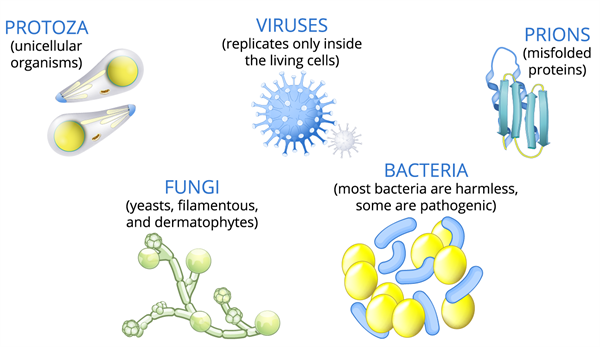
PUMPA - SMART LEARNING
எங்கள் ஆசிரியர்களுடன் 1-ஆன்-1 ஆலோசனை நேரத்தைப் பெறுங்கள். டாப்பர் ஆவதற்கு நாங்கள் பயிற்சி அளிப்போம்
Book Free DemoThere are two types of diseases based on the way it is formed.
- Infectious diseases
- Non-infectious diseases
Infectious disease:
Infectious diseases are diseases created through infectious agents such as bacteria, viruses, fungi etc. These are the diseases caused by external pathogenic organisms that invade our body and can be transferred from human to human or animal to animal through air, water, food or insects.
Hence, the diseases are called as communicable diseases.
Hence, the diseases are called as communicable diseases.
Example:
Influenza, Tuberculosis, Chickenpox, Cholera, Pneumonia, Malaria, etc.
Name of disease | Mode of spread |
| Cholera | Food and water |
| Typhoid | Food and water |
| Hepatitis | Food and water |
| Influenza | Air |
| Tuberculosis | Air |
| Malaria | Mosquito |
| Tetanus | Bite wound exposed to dust or rusted item |
Non-Infectious diseases:
These diseases are caused due to a malfunction in the body system. Pathogens do not cause them. So these diseases don't get transferred from one organism to others. Hence, these diseases are called as Non-communicable diseases (NCD).
They are caused by,
- Malfunctioning of organs
- Genetic abnormalities
- Hormonal imbalances
- Immune system defects
Example:
Diabetes, Obesity, Cancer, Goitre, Coronary heart diseases, etc.
Difference between infectious and non-infectious diseases:
Infectious diseases | Non-infectious diseases |
| Infectious diseases are also called communicable diseases or transmissible diseases as they can spread from infected person to healthy person. | Non infectious diseases are also called non communicable diseases as they do not pass on from one person to another. |
| Infectious diseases caused by pathogens such as viruses, bacteria, fungi, protozoans and worms. | Non infectious diseases caused by factors such as genetics, environment and lifestyle. |
| Infection is transmitted through direct contact or through medium | Infection is not transmitted through direct contact or medium. |
| Examples of infectious diseases are colds, influenza, chicken pox, herpes and measles. | Examples of non infectious diseases are Down syndrome, hemophilia, skin cancer and cardiovascular disease. |
In the below section, we will see how the transmission of infectious diseases occurs.
The following are the steps involved in the transmission of an infectious disease.
- Transmission of infectious agents from a reservoir of infection
- Invading the organism's body through a point of entry
- Residing of microbes in specific organs or tissues
- Incubation of the infectious agent for a certain period
- Occurrence of infection and illness
- Transmission of an infectious agent to other host
Reservoir of infection:
This term refers to a specific environment other than the host where pathogens can grow and multiply without causing disease. In other words, they are the breeding grounds for pathogens.
Point of entry:
Point of entry is how a pathogen passes into the host from the external environment. When the pathogens enter the human body, infection develops inside it.
The pathogen enters the human body through
- Contaminated air
- Contaminated water
- Contaminated food
- Physical contact
- Sexual contact
- Infected animals
Infection may be organ-specific or tissue-specific within our body where the microbes reside.
Incubation period:
The time interval between the start of an infection and the first appearance of the disease is called the incubation period.
This period of infection may vary from several days to hours.
Infection:

Types of infectious agents